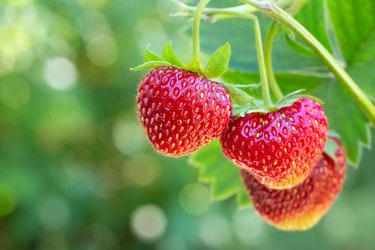
In most of the United States, garden strawberries (Fragaria x ananassa), which are generally hardy in U.S. Department of Agriculture plant hardiness zones 4 through 8, are grown as perennials. In the warmest parts of the country, however, these plants are often grown as fall-planted annual strawberries. Because Georgia's climate varies considerably from north to south, the appropriate strawberry planting strategy in the state depends upon the part of Georgia in which the strawberries are planted.
Planting Times for Annual Strawberries
Video of the Day
In northern and middle Georgia, where the climate ranges from USDA zone 6a through 8a, strawberries grow best as spring-planted perennials. Set the plants in the garden in early spring as soon as the soil is workable so that they'll have time to get established before summer heat arrives in the area.
Video of the Day
In southern Georgia, where the climate falls into USDA zones 8b through 9a, fall planting strawberries leaves them less vulnerable to disease These plants are typically set between the middle of September and Nov. 1, and treated as annuals, replaced each year.
Fall planting strawberries is an option in northern Georgia as well, but the plants may be damaged or killed during especially hard winters.
Varieties for Georgia
The University of Georgia Extension Service lists the cultivars 'Earliglow,' 'Delmarva,' 'Sweet Charlie' and 'Allstar' for the spring-planted perennial technique in northern and middle Georgia, and 'Chandler,' 'Camarosa' and 'Sweet Charlie' for the fall-planted annual approach in any part of the state.
Strawberry Plant Soil Preparation
Strawberries grow best in locations with full-sun exposure and well-drained soil. To prepare a garden bed for spring planting, work a 10-10-10, dry fertilizer into the soil one week before planting, applying it at rate of about 1 2/3 pounds per 100 square feet of planting area.
To prepare for fall planting, work 3 pounds of 10-10-10, dry fertilizer per 100 square feet into the soil, and then mound the soil into a raised bed about 8 inches high at the top of the mound, 6 inches at its shoulder portions and 26 inches wide.
Setting of Plants
Proper planting depth is critical when setting strawberry plants. Each plant needs to be put in a hole about 6 inches deep and wide enough to accommodate its root system so that the plant's crown -- where the foliage emerges -- is at the level of the surrounding soil's surface. Planting too deep can cause the crown to rot, and the roots may dry out if the plant is set so shallowly that the top of its root system is exposed.
When using the spring-planted perennial system, set strawberry plants in two rows in each planting bed, with 2 feet between rows and 2 feet between plants within each row. As the plants grow during summer and send out runners -- horizontally growing above-ground stems that take root where they touch the soil -- to establish new plants, allow the new plants to fill the spaces between the initial plants.
When using the fall-planted annual system, set plants in two rows in each raised bed, spacing the rows 12 inches apart and leaving 12 inches between plants within each row.
Watering Strawberry Plants
Water the soil of strawberry plants thoroughly at planting time, and water the soil of bare-root strawberry plants daily for the first week after planting. Afterward, Southern strawberries transplanted from containers and bare-root plants require 1 to 1 1/2 inches of water each week, including rainfall.